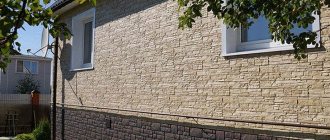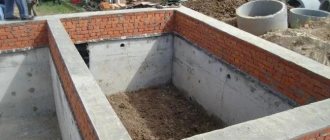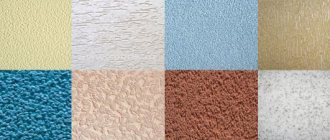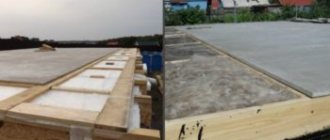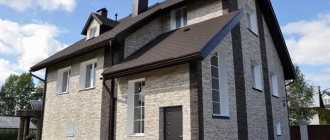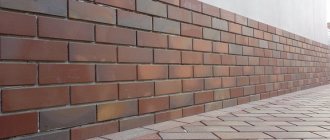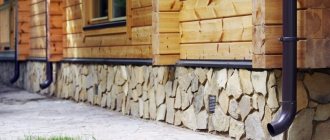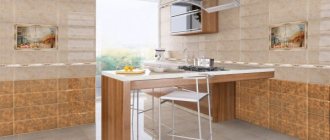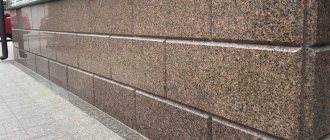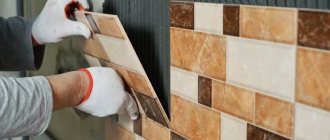A variety of materials are used to finish the base, including porcelain stoneware.
What features does this material have, what types exist, and how to carry out finishing work correctly, we will consider below.
What kind of material is this?
Porcelain stoneware is a very durable , top-class material used for cladding floors, interior and exterior walls of buildings, etc.
For its production, mixtures of various rocks (spar, quartz), as well as clay and natural mineral dyes are used.
One of the main advantages of porcelain stoneware (or kerogranite) is its zero water absorption coefficient. Most of the characteristics of the material are not inferior to natural granite.
Contrary to misconceptions, it does not contain granite , although the physical properties are very close to natural material.
Porcelain stoneware plinth design
Looking at the photo of plinths finished with porcelain stoneware, you can understand that this artificial analogue of natural stone is offered in a wide variety of colors and textures. This allows the owner of a private property to clad the lower part of the house, without in any way holding back the impulse of design thought. This material can be combined with almost any type of wall decoration.
An artificial analogue of natural granite will look good with decorative plaster on the walls, siding and even clinker tiles. This finish looks quite attractive if combined with a contrasting color brick cladding. And if you also decorate the blind area of the building with porcelain stoneware, the exterior of the house will look complete and organic.
Suitability of use for cladding
The material has thermal insulation and sound insulation properties, so it is recommended for use in buildings with a residential basement.
Due to the absence of pores, porcelain stoneware does not allow moisture to pass through and is not afraid of flooding , which makes it possible to use it for finishing foundations in regions with high humidity and snowy winters. And resistance to temperature changes makes this material ideal for regions with hot summers and frosty winters.
Porcelain tiles are well mounted on top of insulation, so those who plan to insulate the foundation before cladding are advised to pay attention to this material.
Finishing with ceramic granite will also be required if you need to give the building a presentable, beautiful appearance.
As a rule, ceramic granite is used for finishing ventilated facades of industrial and public buildings. In low-rise buildings it is often used for cladding walls, terraces, steps, and floors.
Construction of houses
The procedure for finishing the basement of a building is a rather important process that requires special care. Since it is the base that is under strong influence of moisture and other irritants. We will discuss below how to choose the right material for finishing the plinth and how to install it.
Table of contents:
- Features of cladding the basement of a house
- Clinker tiles for plinth cladding
- Cladding the basement of a house with your own hands: stone, polysand and resin tiles
- Features of plinth cladding with artificial stone
- Technology of covering the base with polyvinyl chloride panels
- Mosaic plaster for plinth cladding - technology
- Options for facing the base with brick
Features of cladding the basement of a house
The base is located at the bottom of any building; most often tiles or stones are used to decorate it. The plinth not only performs a decorative function of the building, but also protects it from moisture penetration, dampness, and load distribution.
The base is the basis for the construction of load-bearing walls. Correct construction of the basement affects the quality of the future building.
The most irritating factor for the base is precipitation. In addition, it is influenced by groundwater, and the difference between the temperature in the ground and in the air.
Therefore, the most important requirement for the finishing material used when cladding the base is its stability and protection of this element from moisture. In addition, a properly finished base allows for reliable protection of the foundation.
The process of selecting materials for finishing the plinth should be based primarily on the use of high-strength materials that are resistant to changes in temperature and moisture. At the same time, they must have an attractive appearance and be in harmony with the overall exterior of the building.
There are cases of monolithic finishing of the base, which is a combination of the foundation and the base. For these purposes, concrete, individual blocks, stone or special bricks are used. The elevation of the base above the ground occurs at a level of 500-700 cm.
Most often, the finishing of the base is done after the walls have been erected. It is advisable to do otherwise; the base must be protected immediately after the foundation has been erected. In this case, all work is carried out in the form of waterproofing, plastering, finishing.
Before the start of facing work, a drainage cushion is created, covering the entire perimeter of the structure. It looks like a recess, 150-200 mm wide, the width of which is about half a meter.
After finishing, the recess is filled with gravel, which acts as drainage. After preparing the base, it is plastered using cement-lime plaster. To increase the strength of the structure, in order to connect the base to the foundation, they are reinforced with a special mesh. To provide additional waterproofing of the base, special additives in the form of plasticizers, for example river sand, should be added to the solution.
Varieties
The following types of porcelain tiles exist:
- Glazed tiles are more durable and reliable than ceramic tiles, but prolonged intensive use leads to deterioration in appearance. Therefore, glazed porcelain stoneware is used for interior decoration or cladding of places that are not subject to strong mechanical stress.
- Matte - no polishing method is used in the production process of this material.
- Polished - the material is polished to a mirror finish, which increases its aesthetic properties and cost.
Technical - similar in appearance to ordinary natural granite. It is distinguished by its relatively low price, manufacturability, excellent resistance to mechanical stress and abrasion, but at the same time it has an undemanding appearance.- Structured - has a relief surface, can imitate wooden parquet, natural stone and even fabric.
- Satin - this material is also called “waxed”. Before the firing procedure, it is coated with mineral salts, which give the surface a soft shine. Satin porcelain tiles are not as slippery as polished ones, but they cannot be installed in places with increased mechanical stress.
- Lapped (or lapped) is a material with a combined, heterogeneous structure: half polished, half matte. The outer side of the tile has different areas - smooth, unpolished, rough. Due to its high wear resistance, this material is used in places with high traffic: shopping centers, offices.
- Double backfill - the top layer of such tiles (about 3 mm) consists of coloring components. Products can have bright, saturated colors - green, blue, yellow, red, etc., and at the same time have good resistance to abrasion and mechanical stress.
Finishing the plinth with stone-look facade tiles
Operating procedure:
- Installation of facade tiles under stone is carried out using cement mortar. It is necessary to calculate in advance the number of tiles required for cladding.
- The wall is primed. It will take 5-7 hours for the soil to dry. The cement is diluted with water in a ratio of 1:3 and mixed until smooth. For external work, a reinforced composition is taken with the addition of construction adhesive. The solution is applied to the wall using a spatula and leveled. The grooves are made with a notched trowel.
- The stone is laid according to the selected pattern. You need to start laying from the bottom. For a tighter fit, large slabs are carefully adjusted with a hammer. A thick layer of grout is applied along the edges of the fitted tiles.
- 2-4 hours after the cladding is completed, excess grout protruding from the seams is cut off with a spatula. Small crumbs of the solution are removed with a stiff brush. The top of the tiles is coated with matte varnish, which will highlight the relief.
If you are not confident that you can handle the work yourself, then it is better to use the services of professionals.
What types are suitable for cladding the foundation of a private house?
For cladding, material is used in the form of slabs of the following size:
- 30/30;
- 40/40;
- 60/60.
The thickness of the slabs can vary from 3 to 15 mm. The greater the thickness, the stronger the material, but its cost in this case increases. For the foundation, you can use ceramic granite of small thickness.
Depending on the type, the following is perfect for the base:
- technical,
- polished,
- structured.
How to care for the facade
Since the artificial analogue of natural granite has almost zero ability to absorb water, it is very easy to care for. This can be done using regular cleaning products. Contaminated areas are washed with detergents. The material is generally non-staining, so it may not need to be cleaned at all. The rain will do all the dirty work.
When purchasing tiles with a structured surface, you need to be prepared for the fact that they retain dirt more easily, since the base is matte. It can be washed with a cloth soaked in water. Semi-polished and polished tiles should be treated with water-repellent compounds to clog the pores.
After this, you can use traditional cleaning products. But they should not have a high acid content, as they can harm artificial granite. Seams, which are the gateway to moisture and low temperatures, can be especially affected. The use of products with abrasive particles should be avoided, as careless cleaning of the surface of the material can lead to scratches.
How to choose the right raw materials?
When choosing porcelain stoneware for plinth cladding, experts recommend paying attention to the geometry of the slabs - some manufacturers' products from different batches may differ in size, which complicates the installation process. The thickness of the panels does not matter in this case.
The material for finishing the foundation must meet the following characteristics:
Frost-resistant - this indicator plays an important role when choosing external cladding materials.- Hardness - the tile must have good resistance to impact.
- Low coefficient of water absorption - this property will prevent the accumulation of moisture in the tile.
- Resistance to chemicals - this characteristic is especially important when installing tiles in places near highways where road reagents are used.
- Resistance to UV rays - ensures the durability of the color coating.
- Aesthetic appearance.
Facade cladding. Criteria for choosing façade cladding
It is very important to highlight the points that must be paid attention to when determining the material needed for finishing the facade. In short, the main selection criteria are reliability, aesthetics and affordable price of cladding. Each of these points deserves expanded consideration.
So, for example, you shouldn’t save too much and settle on the “absolutely budget” option, that is, at the expense of the quality of the material. We should not forget that cladding is not only decor, but also a protective coating for walls, and it must withstand aggressive environmental factors, such as rain and wind, snow and frost, ultraviolet radiation and temperature changes, chemical exposure and dynamic loads.
Not every material can withstand the low or high temperatures of certain regions, so it is necessary to take into account the actual conditions in which the material will be used.
Facade cladding is far from just a decorative component: the protective functions of the finish are of great importance
It will not be possible to cladding the facade of a house very cheaply, but choosing the best finishing option with high performance characteristics, which will have a relatively affordable price, is quite possible.
The selection criteria that you should rely on will help not only save some money, but also clearly highlight certain advantages and disadvantages inherent in certain facade finishes.
First of all, it is worth taking a kind of “tour” along the surrounding streets and paying attention to the finished, recently finished facades of buildings that have stood for at least one or two winters. It is quite possible that this will help you decide on the finishing material or, conversely, categorically refuse some of them. To do this, you should focus your attention on the condition of the facades of houses, that is, learn from the mistakes of others, since some finishes show their inconsistency after the first season of operation.
So, the first thing that is usually determined when choosing a material for transforming the walls of a house is the appearance to be created. Here, each owner relies on his own taste, especially since today you can find a large number of finishes on sale, which also have an affordable price. If a certain material is selected based on its external qualities, then before purchasing it, it is worth familiarizing yourself with a number of performance characteristics:
- Moisture resistance of finishing.
- Frost and heat resistance.
- Flammability.
- Tear resistance.
- The strength and durability of the finish is the service life declared by the manufacturer.
- Complexity of installation and number of auxiliary elements.
- Resistance to fading, that is, to ultraviolet radiation.
- The color scheme, texture and similarity of the finish to natural material, if its imitation is chosen.
- Cost of materials and components.
Then a completely clear picture will unfold before the buyer, based on which it will be possible to make a certain choice.
Calculation of the required number of tiles and adhesive composition
One of the main indicators in the calculation is the amount of adhesive used for installation. So, if the weight of a package of 60/60 slabs is 36 kg, and the package contains 4 slabs, then one tile will weigh 9 kg.
The weight of 30/30 tiles is calculated in the same way. Porcelain tiles of this size are usually packaged in 8 pieces, which means the weight of 1 unit will be 1.5 kg. As a rule, 1 package holds 1.2-1.44 m².
When purchasing glue, you need to study the information on the packaging regarding its consumption: the manufacturer must indicate how much adhesive is required to lay a certain number of slabs. On average, 2.5-5 kg of glue is required per 1 m².
According to European standards, the specific gravity of porcelain stoneware is approximately 2400 kg/m² . This data allows you to calculate approximately how much the purchased tile will weigh and what kind of machine you need to hire to transport it.
When purchasing porcelain stoneware in the form of flat tiles, to calculate the material consumption, you will need to multiply the length of the base by its width. The result will be a value equal to the area of the base. Accordingly, the area of the tile will be the same, plus you will need to add 5% for trimming.
Covering the base with clinker tiles
Operating procedure:
- The plinth is covered with clinker tiles using glue. The mixture for applying clinker is supplied and is only suitable for this type of tile. The glue is diluted according to the instructions.
- The optimal clinker value for the base is from 16 to 20 mm. It is convenient to mark horizontal lines with cords. To finish the base with clinker tiles, it is better to mark each row separately. The base must be marked in advance in this way: whole tiles must be laid out so that the cut tiles are not visible.
- The plinth should be covered from the corners from top to bottom. The glue is applied to the wall using a spatula so that grooves remain on it. The back of the clinker is also covered with an adhesive composition. It is necessary to prevent the glue from drying out, as this will reduce the quality of the cladding. You can correct tiles that were installed incorrectly within 15 minutes.
- After the installation is completed, the joints should be grouted with a special compound. The operation is performed using a scoop and jointing. The remaining grout from the clinker is removed with a stiff brush.
Step-by-step installation instructions
Finishing the base can be done in two ways:
- On the frame - between the foundation and the porcelain stoneware surface, space is left for air circulation.
- Using glue , the cladding is installed directly on the surface of the foundation.
To create a ventilated plinth
In the process of arranging a ventilated base, a sheathing is first installed, to which thermal insulation is attached.
As such, you can use both tile and roll materials. The lathing helps to distribute the load on the foundation more evenly and also prevents the formation of condensation. When using insulation, construct 2 rows of sheathing .
For its manufacture, it is recommended to use a metal profile, since the wooden frame will quickly deteriorate from moisture.
When installing the profile, you need to make sure that it does not fit too tightly to the foundation - this will protect it from corrosion.
Ceramic granite is fixed using stainless steel fasteners . To increase the reliability of the structure, experts recommend additionally using cement mortar - it is used to fill the space between the porcelain stoneware and the profile.
On glue
The plinth can be faced with porcelain tiles using an adhesive specially designed for this purpose. This method allows you to carry out facing work both with and without insulating materials.
The installation process is carried out as follows:
- after installing the insulation, its surface is primed and covered with sickle mesh;
- glue is applied to the back surface of the tile;
- then a profile is installed in the lower part of the foundation, on which the first row of cladding will be laid out;
- After that, the tile is applied to the foundation and slightly moved to install it in the desired position. It is necessary to start laying tiles from the bottom corner;
- subsequent elements are laid out in the same way. To maintain equal intervals between them, cross-shaped beacons are used;
- When the adhesive solution has completely hardened, the last stage is performed - grouting the joints.
Wall cladding with porcelain tiles without support - in the video:
Useful properties of porcelain stoneware
As a facing material, porcelain stoneware for plinths is not found in natural conditions, but is produced artificially. It is based on various types of clay, as well as granite chips and some minerals. As a result of the complex technology of pressing all components, their subsequent drying and high-temperature firing, it is possible to create a cladding material that is homogeneous in structure and durable. Limited additives in the form of oxides of various metals make it possible to give porcelain stoneware a wide range of color shades. It is enough to look at how varied in color the facades of photo porcelain stoneware houses are in order to appreciate the aesthetic appeal of this material.
You can finish the base with porcelain stoneware as in this photo - with a zigzag
Useful properties that make this artificial material ideal for cladding a porcelain stoneware house:
- exceptional strength;
- resistance to deformation;
- impermeability to moisture;
- resistance to low temperatures.
- absolute fire safety;
- environmental cleanliness.
If the base is faced with porcelain stoneware, then you can be sure that such material is able to withstand numerous cycles of changing summer and winter temperatures without any damage. It is not afraid of freezing, since its dense structure has virtually no pores into which moisture could enter. But cracking of the facing material in the cold occurs precisely because water droplets, turning into ice, provoke the occurrence of cracks.
One of the types of porcelain stoneware - buratato
Good to know. Along with the function of protecting the base, the decorative finishing of the house with porcelain stoneware is also important; the photo demonstrates how much more elegant and noble the appearance of the building becomes.
Possible errors during the installation process
When installing the first row of tiles, you must be as careful as possible, since the appearance of all other rows depends on the quality of its installation.
During the installation process it is necessary to use a level. With its help, they check how correctly each element is installed.
The aesthetics of covering a foundation with porcelain stoneware depends on the quality of the surface on which it is laid. If the surface is uneven, you will need to level it with cement mortar, and only then proceed with installation.
Carrying out work independently
All work on cladding the basement of the building (if you have some experience) can be done with your own hands. The choice of one or another insulation will largely depend on the material from which the house was built, as well as on the presence of internal insulation in the basement.
You need to understand that covering the base with porcelain stoneware is not a cheap pleasure. But for this money you will get a monolithic, reliable, durable and high-quality finish that will delight you and your guests with its attractive appearance.
Average prices
The cost of porcelain tiles depends on:
- his appearance,
- manufacturing technologies,
- quality,
- manufacturer and some other indicators.
Products from European companies tend to be more expensive compared to domestic ones. Most products from European brands are premium. 1 m² of such tiles costs at least 550 rubles.
The leading positions among European manufacturers are occupied by Spanish, Italian and French companies. In recent years, the Czech company Lasselsberger and the Polish Cersanit have begun to join their ranks.
Russian manufacturers include:
- Kerabud,
- Estima,
- Italon,
- Stroyfarfor,
- Grasaro,
- Marazzi,
- Ural granite.
The tiles of the listed Russian companies are distinguished by a large selection of sizes, textures and shades, and comply with European quality standards.
Most products from Chinese manufacturers are economy class and cost significantly less than in Europe. Thus, the cost of Fiorano porcelain stoneware is 360 rubles per 1 m².
Prices for glue depend on its brand, quality and manufacturer. Adhesive compositions are packaged in 25 kg bags, the cost of which can be 190-500 rubles.
Prices for installation work depend on the installation method. The average price for installation using the curtain wall method is 2,400-3,200 rubles, and specialists charge 1,000-1,500 rubles for laying tiles with glue. for 1 m².
What components are required for installation?
To perform installation work you will need the following materials:
- Tiles and concrete; Level; Stainless steel fasteners and guides; Self-tapping screws; Frame strips; Insulating material.
In addition to the listed tools and devices, you also need at least basic knowledge in this area. After all, the effectiveness of the cladding as a whole depends on how competently the laying of each tile and the entire layer is done.
If you do not have the necessary skills, then it is better to entrust this work to professionals. Although in general terms it is not that complicated, and can be done independently if desired.
Pros and cons of using
Despite the fact that porcelain stoneware is produced in a factory, such cladding is considered natural. This is due to the absence of artificial impurities in its composition.
Finishing the foundation with porcelain stoneware has the following advantages:
- The material is highly resistant to deformation.
- It has good sound and heat insulation properties.
- Resistant to fire.
- Excellent moisture repellent.
- Has an attractive appearance.
- It is easy to install, as it is produced in the form of even slabs.
The only drawback of the material in question is its high cost.
What is a ventilated façade?
With this approach to organizing protection, another additional wall is created, located at some distance from the main one and attached to it in a special way. As a result, the wall of the house is protected from direct influence from the atmosphere, and the existing gap between the main and auxiliary walls allows one to avoid the accumulation of moisture, dampness and, accordingly, rotting processes.
A long service life is ensured by the manufacture of a ventilated facade from porcelain stoneware. Of course, other materials are used in the design, but porcelain stoneware provides protection from external influences.
Thanks to this approach to organizing building protection, which is unusual for traditional construction, it provides the following advantages:
- the ventilated facade made of porcelain stoneware is all-season, its installation can be carried out at any ambient temperature;
- such facades have a long service life without the need for ongoing repairs;
- ventilated facades made of porcelain stoneware are resistant to any external influences;
- cheap, practically requiring no additional costs, operation.
Photo
Photos of buildings lined with porcelain stoneware:
A variety of options for finishing the basement of a private house are presented in this section.
You will find all the most important, interesting and useful information about finishing the basement in this section.
Types of base
The base may be different:
- Sunken plinths. Such plinths are easier to protect from climatic influences, there is no need to organize a low tide, and the cladding is less affected by rain and snow;
- Protruding plinths. A similar basement of a house is used in the construction of housing with thin walls. Low tide is necessary, otherwise water will flow down the walls, accumulate near the foundation and gradually destroy it;
- Basement and wall are on the same level. There are options where the wall and base are on the same level. Such schemes are rare; they need an ebb. The problem with the plinth is the difficulty of organizing effective waterproofing.
If we look at the issue from a practical point of view, the basement level only requires ebb and flow and waterproofing. But many people care about the aesthetic component. Therefore, finishing the basement of a house is a regular event when creating a completed private home.
How to determine how much material is needed? What are the installation details?
Let's see using the first option as an example. Basement areas of buildings are never short, and over long lengths it is not easy to maintain the correct finishing geometry. A beautiful, airtight and reliable coating depends on the thoroughness of the preparatory work.
Video details from professionals: façade cladding with clinker tiles
First, a metal profile is mounted level on the bottom of the base. The profile will help to lay the first row of clinker tiles evenly. It’s easier to drive everyone else away from the first row.
To find out how much material you need, measure and calculate. The height of the base should be divided by the width of the tile, the resulting figure will allow you to understand how many rows are needed and where to start.
Don’t forget to calculate the width of the seams: if the seam is 2 mm, then for 10 rows of tiles this is at least an additional 2 cm.
The metal profile will become a reference point from where you can measure the height of the base that needs to be covered. Calculate so that there is no waste, there is beautiful geometry. Tiling the base begins with preparatory work and surface work.
Subtleties of installing clinker tiles on the facade - video
High adhesion and a reliable surface are achieved due to a flat plane, absence of cracks, grease stains, and dirt. The surface must be clean, dry and primed. The primer reduces the water absorption of the building and promotes better adhesion of the clinker to the plane of the building.
If necessary, deep penetration primers and antifungal products are used. Is reinforcement necessary? This is a measure that promotes tight and reliable contact of the tiles with the wall.
The reinforcing mesh is attached with dowels; it must be parallel to the mesh and not protrude anywhere.
